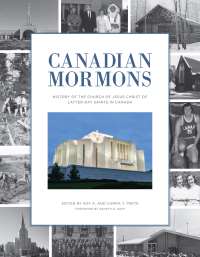Global Perspective
LeRoy E. Whitehead
Leroy E. Whitehead, “Global Perspective,” in Canadian Mormons: History of the Church of Jesus Christ of Latter-Day Saints in Canada, ed. Roy A. and Carma T. Prete (Provo, UT: Religious Studies Center; Salt Lake City: Deseret Book, 2017), 544-565.
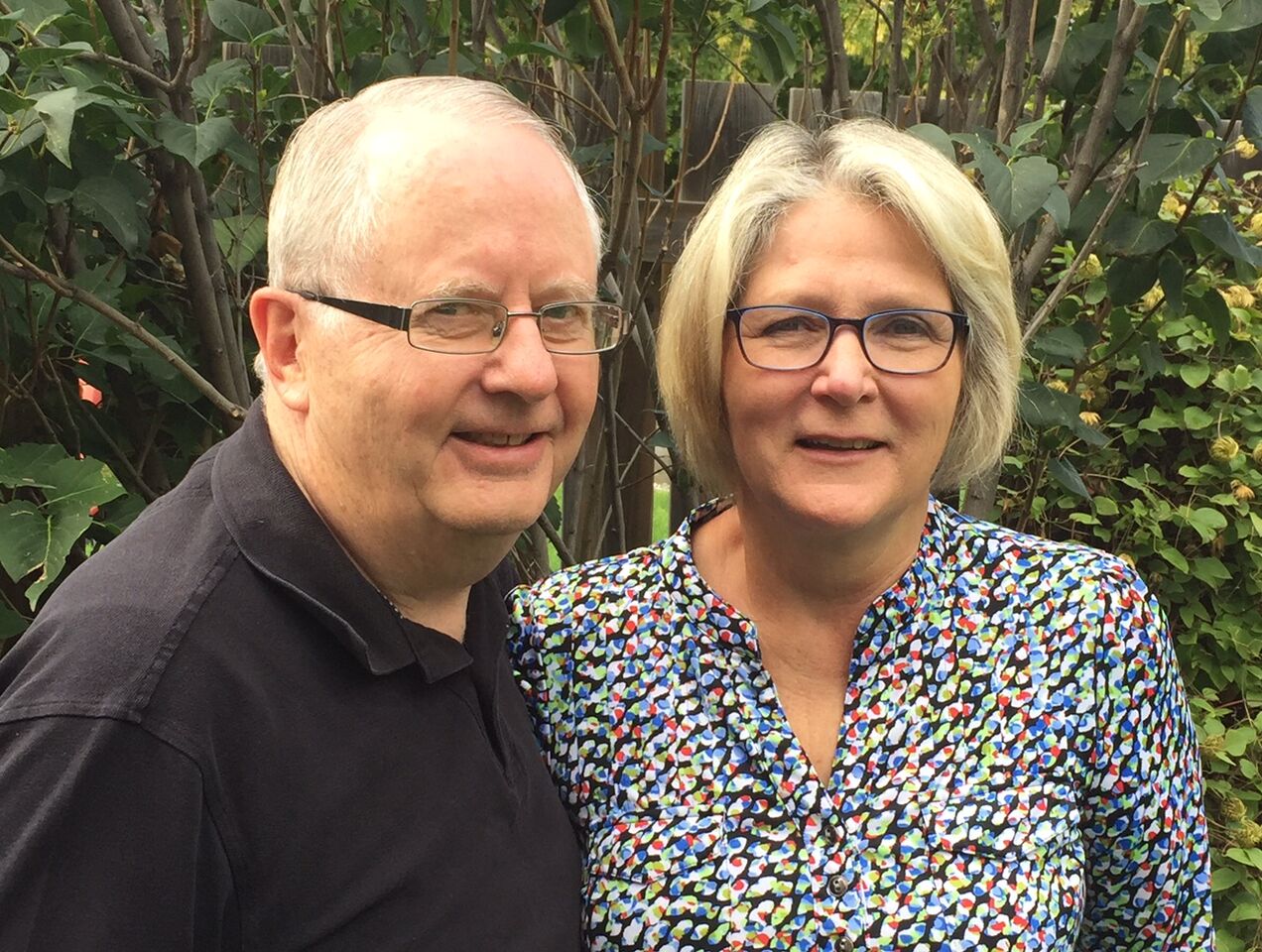
LeRoy E. Whitehead obtained his PhD in education administration from the University of Calgary before moving from Alberta to Ontario. A faculty member for thirty-five years (now retired) in the faculty of education at Queen’s University, Kingston, Ontario, he served for thirteen years as associate dean. His publications and research have been in education foundations, education reform, and transnationalization of teacher education. He has served as bishop, high councilor, and counselor in a mission presidency. As a young man, he served a mission in Hong Kong. Most recently, he and his wife, Patricia Plowman Whitehead, served as a senior missionary couple in Suva, Fiji. They are the parents of six children and grandparents of three boys. (Patricia Whitehead)
 From its organization in 1830 with six charter members, The Church of Jesus Christ of Latter-Day Saints has grown to become a global religion of nearly 16 million in 2016, with a full official presence in most countries with religious freedom. It has acquired a limited public presence with wards and branches, but without missionaries, in several other countries. Canada has been a partner in this remarkable expansion since the early days of the Church.
From its organization in 1830 with six charter members, The Church of Jesus Christ of Latter-Day Saints has grown to become a global religion of nearly 16 million in 2016, with a full official presence in most countries with religious freedom. It has acquired a limited public presence with wards and branches, but without missionaries, in several other countries. Canada has been a partner in this remarkable expansion since the early days of the Church.
The growth and development of The Church of Jesus Christ of Latter-day Saints in Canada is part of the larger story of the expansion of the Church worldwide. To be fully understood, the Canadian story needs to be viewed alongside the growth and development of the Church in the United States, because the history of the Church in Canada has been intimately connected with that of the Church in the United States, and growth patterns of the Church in both countries have been remarkably similar. In addition, the growth of the Church in both Canada and the United States must be viewed against the backdrop of the dramatic growth and globalization of the Church since the Second World War. In 1951, only 11 percent of the Church’s 1.1 million members lived outside the United States and Canada. By the end of 2015, sixty-four years later, worldwide membership had risen to more than 15.6 million,[1] with almost 60 percent residing outside the United States and Canada. The map on the opposite page highlights countries in which the Church has an official presence as of 2016. It also shows several countries, including China and various countries in North Africa and the Middle East, where the Church has a presence but where missionaries are not allowed.
This chapter will provide both global and North American contexts within which the rich history of the Church in Canada can be situated and better understood. The growth and globalization of the Church worldwide in the decades following World War II will be illustrated by a selection of four key indicators: members, countries, temples, and missionaries. The focus will then narrow to North America with a brief review of postwar growth in Canada and the United Sates, as well as a brief discussion of the recent “religious landscapes” in the two countries. Finally, the focus will broaden again to compare the status of The Church of Jesus Christ of Latter-day Saints with that of other Christian and non-Christian religions worldwide, and consider a question some prominent sociologists and historians of religion have been asking; Is Mormonism on the verge of becoming a “new world religion”?
Unto Every Nation: Membership Growth and Global Dispersion
The Church of Jesus Christ of Latter-day Saints was organized in a log cabin in upstate New York on 6 April 1830 with six charter members, though it is estimated that about fifty people were present at the organizational meeting.[2] Since the Church’s earliest beginnings, the Prophet Joseph Smith and successive Church leaders have held a vision of taking the restored gospel of Jesus Christ to the entire world. This vision has roots in the New Testament injunction “Go ye therefore and teach all nations” (Matt. 28:19, Mark 16:15), but it is also an important theme in latter-day revelations as recorded in Doctrine and Covenants (for example, D&C 1:1–5; 84:62–64). In an important document known as “The Wentworth Letter,” dated 1 March 1842, Joseph Smith captured the urgency of the vision, declaring, “The Standard of Truth has been erected: no unhallowed hand can stop the work from progressing, persecutions may rage, mobs may combine, armies may assemble, calumny may defame, but the truth of God will go forth boldly, nobly, and independent till it has penetrated every continent, visited every clime, swept every country, and sounded in every ear, till the purposes of God shall be accomplished, and the Great Jehovah shall say the work is done.”[3]
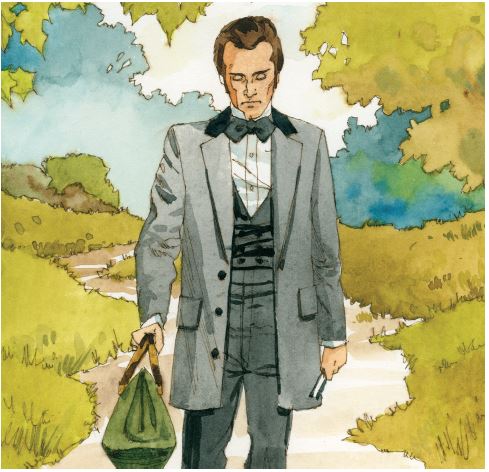 Samuel Smith, brother of the Prophet Joseph Smith, was the first missionary in this dispensation. Though not well-received in many places, some remarkable conversions resulted from copies of the Book of Mormon he distributed. (Intellectual Reserve, Inc. [hereafter, IRI])
Samuel Smith, brother of the Prophet Joseph Smith, was the first missionary in this dispensation. Though not well-received in many places, some remarkable conversions resulted from copies of the Book of Mormon he distributed. (Intellectual Reserve, Inc. [hereafter, IRI])
It is clear Joseph Smith understood that accomplishing the mission would not be easy, and he was right: persecutions have raged, mobs have combined, armies have assembled, and calumny has defamed. Nonetheless, the work of the Church has continued as circumstances and resources have permitted.
Global Membership Growth
Within days or weeks of the Church’s organization, Joseph Smith’s brother Samuel was sent out as the first official missionary. Others followed, and by the end of 1830, Church membership had reached 280.[4]

The table in figure 19.1 shows total Church membership worldwide at end of decade, from 280 members at the end of 1830 to 15,634,199 at the end of 2015.[5] The table also shows the net member increase over the previous decade in terms of both numbers and percentages. The net member increase figures represent the difference between new members gained and members lost.
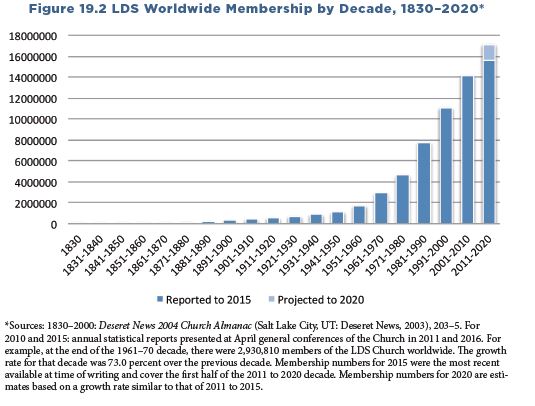
For easier visualization, the total worldwide membership numbers shown in figure 19.1 are presented in graph format in figure 19.2. Figure 19.3 shows the net member gain numbers in graph format. It is easy to see the beginnings of a steep growth curve after 1950. Note that the net member increase for 1951–60 more than doubled that of the previous decade (1941–50). It then more than doubled again during 1961 to 1970. During the 1981 to 1990 decade, the net member increase exceeded three million for the first time. During the two decades from 1991 to 2011, net member increases continued to reach or exceed three million per decade. As of 2017, net membership growth between 2011 and 2015 appears on track to reach or exceed three million again at the end of the full decade in 2020.
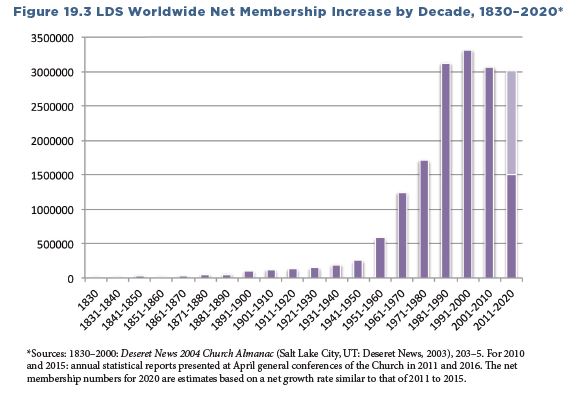
For comparison, the line graph in figure 19.4 shows the annual percentage growth rates (three-year moving average) for the world, the United States, and Canada from 1965 to 2015. While Canadian membership numbers have been much smaller, the percentage growth pattern of the Church in Canada has followed somewhat the same pattern as that of the Church worldwide, though it more closely resembles that of the United States. At the end of 1965, the LDS Church in Canada had 47,945 members.[6] Fifty years later, at the end of 2015, the Church had 193,850 members in Canada, divided among 486 congregations, with locations in every province and two of the three territories.[7]
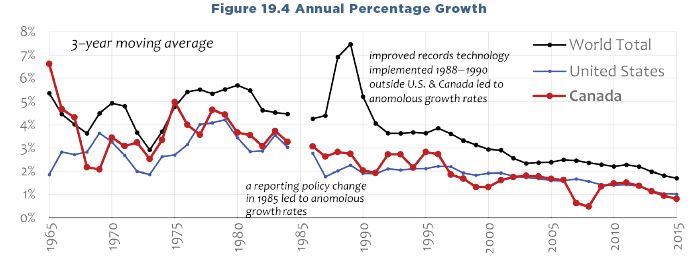
Sources of New Members
As with any large voluntary organization, the number of members of the Church worldwide varies from day to day as new members are baptized and confirmed and as existing members are lost through death, formal resignation of membership, or excommunication.[8] New LDS Church members are generated from two sources: “children of record” and converts. Children of record are the children of Church members who are blessed (not baptized) as infants and listed on the membership records of the Church in anticipation of their baptisms and confirmations at age eight. Converts include adults and their children eight years of age or older who come to the Church from other faith traditions (or from no faith) through the Church’s missionary outreach.[9] During the forty-four-year period from 1971 through 2014, approximately 25.2 percent of new members worldwide were children of record, while approximately 74.8 percent of new members were converts.[10] During the same forty-four-year period, an estimated 1,536,471 members were lost through death, resignation, or excommunication.[11]
 The Relief Society, organized in 1842, is the oldest women’s organization in the world. This quilt, created for the Relief Society sesquicentennial in 1992, depicts women worldwide engaged in spiritual, creative, and service activities. (IRI)
The Relief Society, organized in 1842, is the oldest women’s organization in the world. This quilt, created for the Relief Society sesquicentennial in 1992, depicts women worldwide engaged in spiritual, creative, and service activities. (IRI)
Global Dispersion: Countries
In 1950, the Church had organized congregations in less than fifty countries.[12] As historian Richard O. Cowan has pointed out, the Church at the end of World War II was essentially a North American church with outposts in Europe and the Pacific. Most of the growth in Latin America, Asia, and Africa has taken place since World War II.[13] By the end of 2015, the Church claimed an official presence in 158 countries and territories. The map at the beginning of this chapter shows that the Church now has an official presence on every continent and on many of the islands of the sea, as well as a limited public presence in many places.
The map also shows that the gospel message has not yet visited every clime, swept every country, nor sounded in every ear as Joseph Smith prophesied it would. There is only limited LDS presence in China and in a few Islamic countries in North Africa and the Middle East, and none in several others in that region. The great dividing line is religious freedom: the Church has a full presence in virtually every country that permits religious freedom. Countries with limited religious freedom have less LDS presence, while several countries lacking religious freedom have no LDS presence.
Global Dispersion: Members
In 1950, worldwide membership had grown to 1,111,314,[14] with 92 percent of members living within the borders of the United States of America, mostly in Utah and parts of surrounding states like Idaho, Oregon, Nevada, Wyoming, Colorado, and New Mexico.[15] The other eight percent were scattered thinly among the other countries, including Canada. However, by the end of 2015, approximately 58 percent of the members were living in countries other than the United States.[16] The geographical balance of the membership shifted in 1996. On 28 February of that year, the Church announced that slightly more than half of its worldwide membership was then living outside of the United States: 4.720 million members outside of the United States, 4.719 million within the United States.[17]
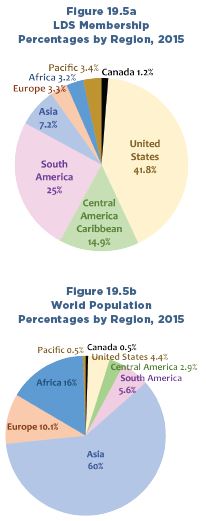 Figure 19.5a LDS Membership Percentages by Region, 2015; Figure 19.5b World Population Percentages by Region, 2015
Figure 19.5a LDS Membership Percentages by Region, 2015; Figure 19.5b World Population Percentages by Region, 2015
The chart in figure 19.5a shows how the Church’s worldwide membership was distributed among six world geographical regions at the end of 2015.[18] The regions, ranked here in descending order according to their numbers of members, are North America, South America, Asia, Oceania (Pacific), Europe, and Africa. Breakout data are provided for the North American region (United States, Mexico, Canada, Central America, and the Caribbean). The chart in figure 19.5b shows world population estimates for mid-2015 for six similar (though not identical) world geographical regions.[19]
Comparing the Church membership and world population data sets shown in the two charts, we see that at the end of 2015, about 83 percent of the Church’s membership was in North, Central, and South America (including the Caribbean), while the same territory had only about 13 percent of world population. Conversely, about 17 percent of the Church’s membership was in Europe, Africa, Asia, and Oceania (Pacific), while this same territory had about 87 percent of world population. The data also show that while the United States no longer has the majority of the Church’s worldwide membership, it still has a large plurality. Nonetheless, it is now fair to say that the Church is no longer merely a frontier religion of the western United States, nor even merely of “mainstream America.”
 Figure 19.6 Total LDS Membership by Region, 1950-2015
Figure 19.6 Total LDS Membership by Region, 1950-2015
The dramatic change in the worldwide distribution of membership over time is illustrated in the graph in figure 19.6. There is still opportunity for both membership growth and geographical outreach to additional countries in Africa, the Middle East, Eastern Europe, and Asia as political and social conditions and the Church’s financial and human resources permit.
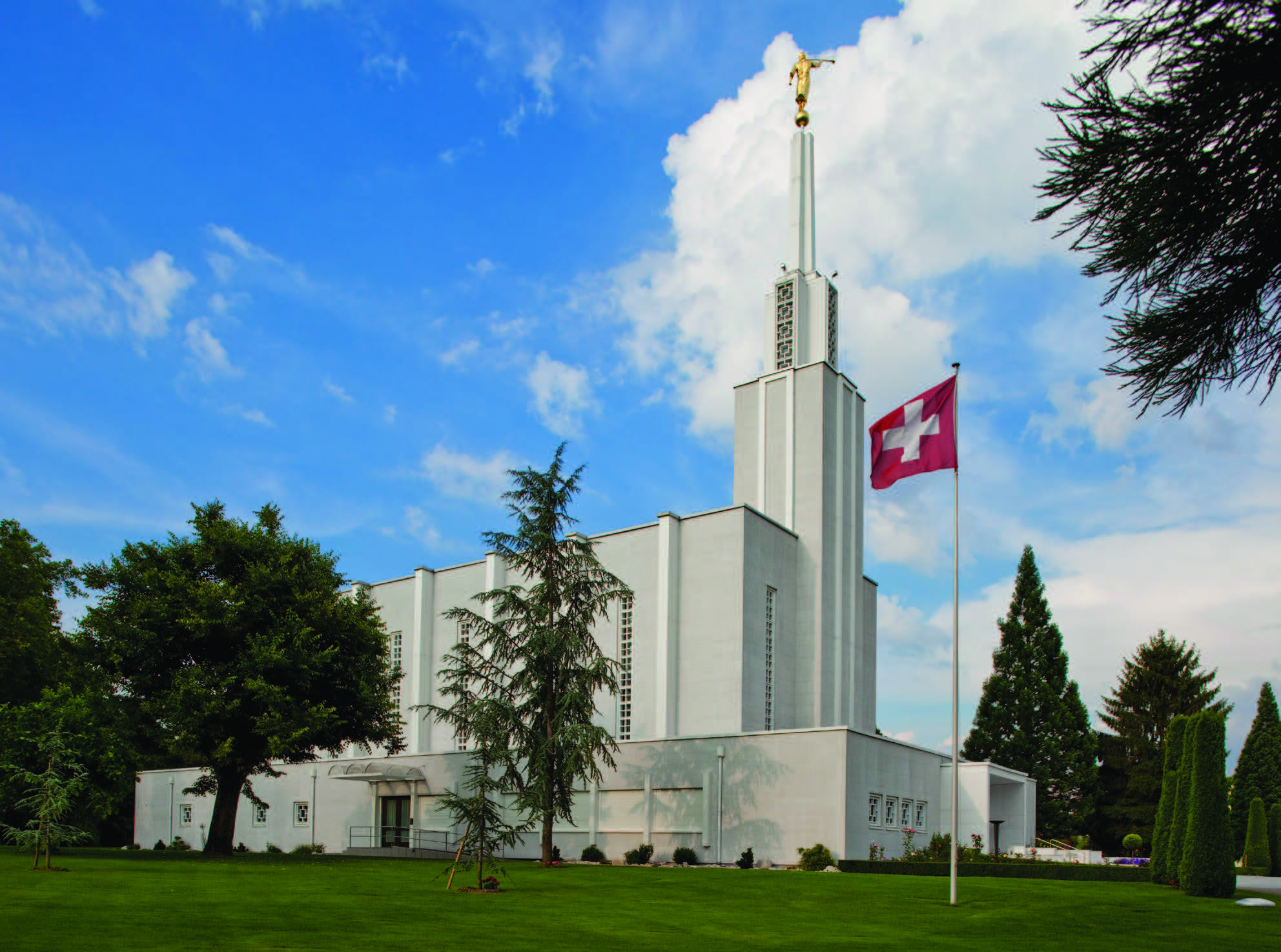 The Swiss Temple, dedicated in 1955 by Church President David O. McKay, was the first LDS temple to be built outside the United States and Canada. Temple ordinances there were available in various European languages. (IRI)
The Swiss Temple, dedicated in 1955 by Church President David O. McKay, was the first LDS temple to be built outside the United States and Canada. Temple ordinances there were available in various European languages. (IRI)
Statistics Canada’s estimate of the Canadian population for mid-2015 was 35,851,800,[20] just under one-half of one percent (0.48) of the total world population. The Canadian percentage of total LDS population has been fairly consistent through this entire period, declining only slightly from about 2 percent in 1950 to 1.3 percent in 2010. At the end of 2015, members living in Canada accounted for about 1.2 percent of the Church’s worldwide membership.
Global Dispersion: Temples
The ordinances and covenants of the temple are central to Latter-day Saint belief and practice. The Church’s first temple was built at Kirtland, Ohio, and was dedicated on 27 March 1836. That building is now in the possession of the Community of Christ (formerly the Reorganized Church of Jesus Christ of Latter Day Saints). The second temple, built at Nauvoo, Illinois, was abandoned in 1846 as the members of the Church were being forced under threat of violence to evacuate the state. The building was later destroyed by arson and the property passed into other hands.[21] It was not until 1877, thirty-one years later, that another temple was dedicated in St. George, Utah.[22] By 1950, the Church had eight dedicated, operating temples: four in Utah and one each in Hawaii, Alberta, Arizona, and Idaho.
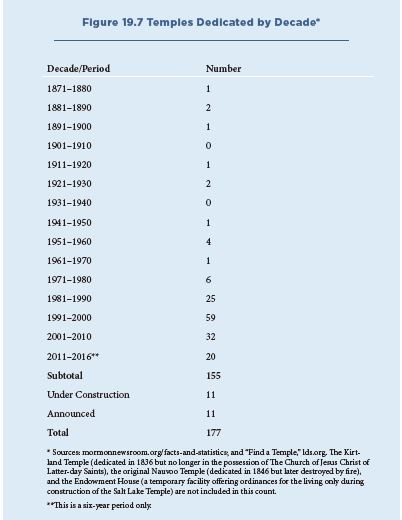
The table in figure 19.7 shows a steep growth curve in the number of temples dedicated beginning in the 1970s, coinciding with the dramatic surge in membership growth. Note the sharp upward curve during the 1981 to 1990 decade, and the peak of the curve during the 1991 to 2000 decade. At the end of 2015, the Church had 149 dedicated temples, with another 16 under construction and 11 more announced temple projects in various stages of planning, site selection, design, and permit procurement.[23]
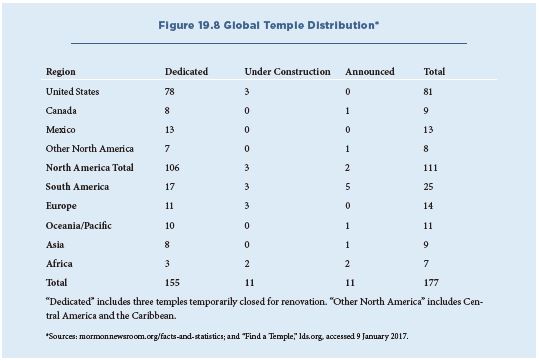
The table in figure 19.8 shows how the operating temples, temples under construction, and announced temple projects are distributed throughout the same six geographic regions used previously for describing the distribution of Church membership. It includes breakout numbers for the North American region. A comparison of the data in figures 19.5a and 19.8 shows that, worldwide, the proportional distribution of temples in the geographical regions is coming close to matching, broadly, the distribution of the membership. The North and South America regions together have about 83 percent of the worldwide membership and about 77 percent of all temples (including those dedicated, under construction, and announced). Asia, Oceania, Europe, and Africa together have about 17 percent of the membership and about 23 percent of all temples. Canada, with just over one percent of worldwide membership, has about five percent of all temples (eight existing temples with an additional temple announced for Winnipeg, Manitoba).
One Million Missionaries
The rapid growth and globalization of The Church of Jesus Christ of Latter-day Saints could not have occurred without a large cadre of full-time volunteer missionaries. Samuel Smith, the Church’s first official missionary, was soon joined by others. A total of sixteen missionaries were called into service during 1830.[24] Despite external persecution and internal difficulties, the missionary outreach continued as circumstances, financial means, and human resources permitted, both in the United States and in a gradually increasing number of foreign jurisdictions, beginning with Upper Canada in 1830. During a news conference held 177 years later, on 25 June 2007, Church President Gordon B. Hinckley announced, “It is reliably estimated that a million missionaries have served since the organization of the Church.”[25] At the time of the announcement, the Church had about fifty-three thousand missionaries in service and about thirteen million members.[26]
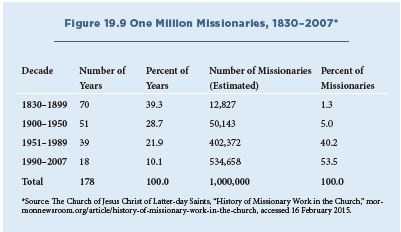
The table in figure 19.9 shows the number of missionaries called to serve during four time periods from 1830 to June 2007. Only 6.3 percent of the million were called during the 120 years from 1830 to 1950. The overwhelming majority, 93.7 percent, were called during the 57 years from 1951 to 2007. More than half of the million were called during the final 18 years (1990–2007) covered by the table data. By 2013, about 6 years later, the total number of missionaries called since 1830 had risen to about 1.3 million.[27]
As of 2 July 2014, the number of missionaries currently in service was 85,593. This number was expected to peak during the fall of that year and then begin to decline, settling somewhere in the high seventy thousands.[28] At the end of 2015, 74,079 full-time proselyting missionaries were currently in service.[29] As part of that large number, Canadian missionaries have been called to serve on every continent and in many island nations.
Figure 19.10 Composition of LDS Missionary Cadre, July 2014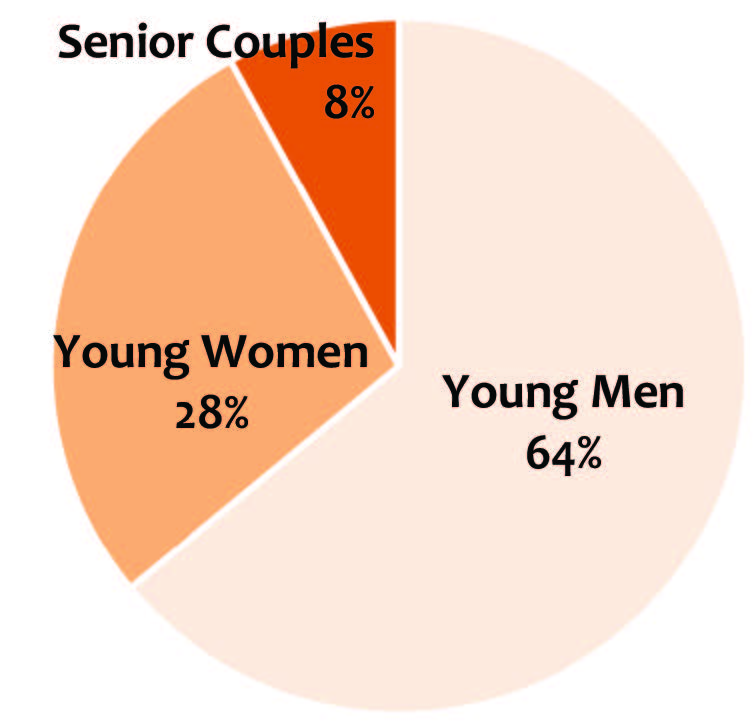
Historically, most full-time proselyting missionaries have been young men. However, in recent years, more young women and senior couples are joining the missionary force. The first sister missionaries were called in 1898.[30] Currently, young men typically serve for twenty-four months and are eligible to serve as early as age eighteen if they have completed secondary school. Young women serve for eighteen months and are eligible to serve beginning at age nineteen. Senior missionaries may elect to serve for six, twelve, eighteen, or twenty-three months and are typically retired with no dependent children living at home. Senior missionaries often serve in humanitarian or support roles rather than in frontline proselyting roles. As indicated in figure 19.10, as of 1 July 2014, 64 percent of the Church’s full-time missionaries were young adult men, 28 percent were women, and 8 percent were seniors.[31]
The Canadian Experience
In the post–World War II period, the “religious landscape” in Canada has changed dramatically. The data suggest three main trends: the decline of religious affiliation generally; the shift of mainline Protestant affiliation to either no religious identification or to other, more conservative Christian denominations; and the increase of non-Christian religious affiliation.
In the 1951 Canada census, 96 percent of respondents self-identified as Christian.[32] The breakdown within the Christian category follows. Catholic/
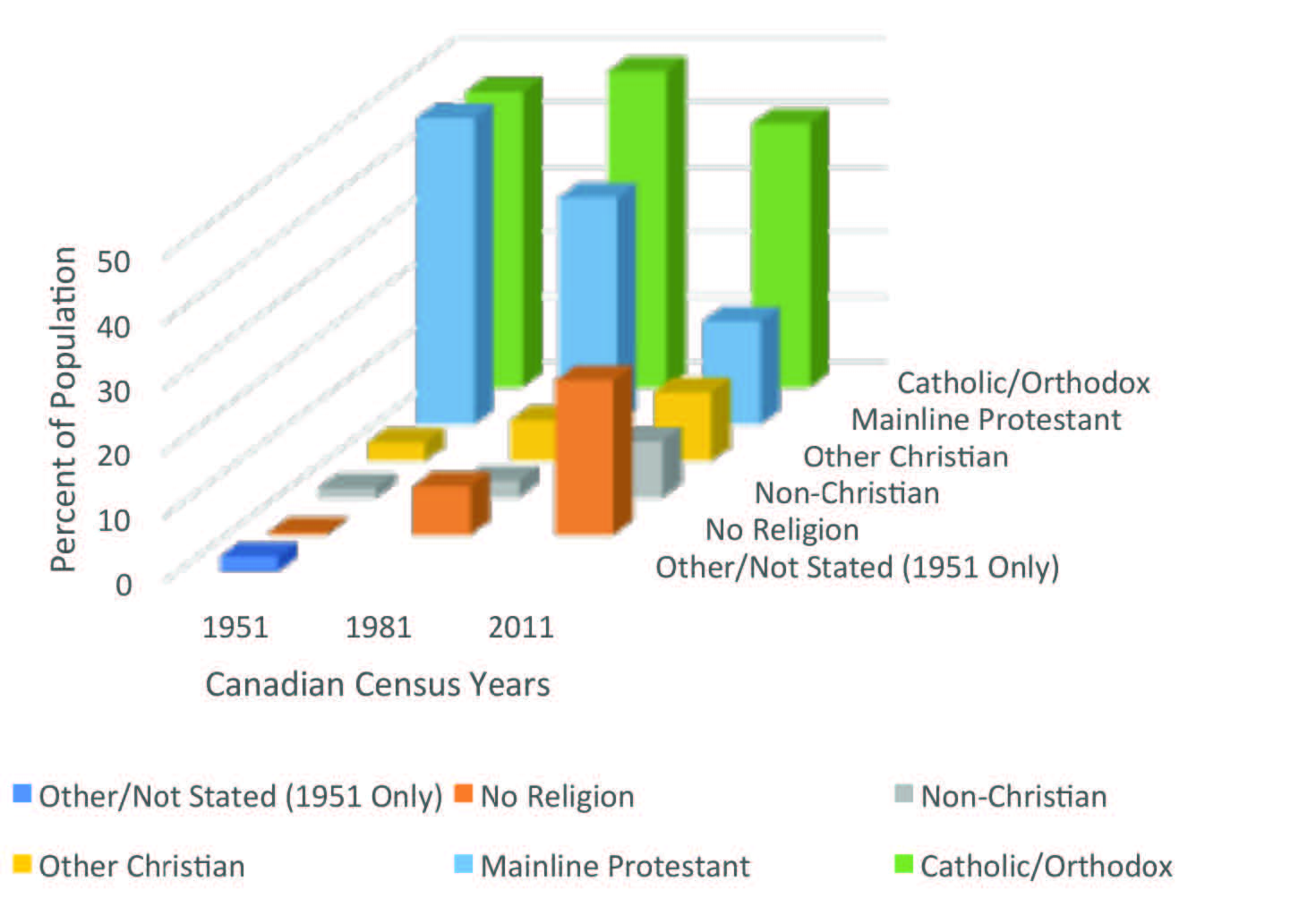 Figure 9.11
Figure 9.11
Three decades later, the proportion of respondents self-identifying as Christian in the 1981 Canada census had declined to 90 percent.[33] By 1981 the long-term trends had begun to emerge. As indicated in figure 19.11, the Christian category had altered as follows: Catholic/
Another three decades later, in 2011, the long-term trends had become much more pronounced. As indicated in figure 19.11, the proportion of respondents self-identifying as Christian in Statistics Canada’s 2011 National Household Survey had dropped precipitously to 67 percent.[34] The distribution within the Christian category was as follows: Catholic/
The Roman Catholic Church, which stayed relatively steady from 1951 to 1981, declined noticeably between 1981 and 2011, though it remained the largest single religious denomination in Canada. This steadiness may be partially attributable to immigration. Though the percentages of immigrants who identified as either Catholic or Protestant had both been declining between 1971 and 2011, the percentage of immigrants who were Catholic remained higher than the percentage who were Protestant.[35] This may have enabled the Roman Catholic Church to make up for the loss of some Canadian-born adherents during a generational shift away from religion, as discussed in the next section of this chapter. The widespread incidence of government funded Catholic confessional schools across the country also may have played a significant role in the relative stability of number of adherents.
The mainline, traditional Protestant denominations, which declined gradually between 1951 and 1981, fell dramatically between 1981 and 2011. This may be attributed to adherents leaving the traditional Protestant churches in favour of either self-identification as having no religious affiliation or movement to more conservative Christian denominations. Canadian sociologist of religion Reginald Bibby has attributed the decline in mainline denominations primarily to the “aging” of the congregants, in that older adherents were dying and not being replaced through either births or immigration.[36] Available data confirm that the percentage of immigrants who were affiliated with the Protestant faith declined somewhat between 1971 and 2011.[37]
While mainline Protestant denominations have been in decline, smaller conservative Christian denominations, grouped in the “other Christians” category, which have maintained traditional Christian beliefs and moral practices, have shown considerable growth, rising steadily from 2.9 percent in 1951, to 6.3 percent in 1981, to 10.7 percent in 2011. Many of these conservative churches maintain traditional theological positions, sustain traditional Christian moral values, and make more demands of their adherents than do the mainline churches. Several of them also have strong youth programs and extensive missionary and outreach programs.[38] The Church of Jesus Christ of Latter-day Saints is known as a religion that maintains comparatively conservative doctrinal views and makes considerable demands of its members, including that of missionary service and strong youth programs. This may explain in part the Church’s remarkable growth during this period of declining religiosity.
Between 1951 and 2011, there was a noticeable rise in non-Christian religions in Canada, from about 1.5 percent of the population in 1951 to nearly 9 percent in 2011, an increase of nearly 600 percent. This is attributable in large part to changes in Canada’s immigration policies beginning in the 1960s, which admitted larger numbers from non-European countries. Data from the 2011 National Household Survey showed that while 23 percent of respondents who came to Canada as immigrants during the 1971–80 decade reported affiliation with non-Christian religions, 39 percent of those who arrived between 2001 and 2011 were of non-Christian religions, a significant increase.[39]
The proportion of the population reporting no religion grew from about 0.5 percent of the population in 1951 to about 7.0 percent in 1981. The dramatic growth, to almost one-quarter of the population (23.9 percent), came between 1981 and 2011. This follows a general North American trend to be discussed below. Data from the 2011 National Household Survey suggest that between 1971 and 2011, the proportion of immigrants arriving in Canada who reported no religious affiliation fluctuated between 20 to 23 percent, though it is possible that some disaffiliated from religion after arriving in Canada.[40]
A North American Context
Though the continental landmass of North America includes Mexico, the focus here will be limited to Canada and the United States of America. These two countries both have histories of colonial status in the British Empire, and both have had a history of religious freedom. Though there have been times of tension and even hostilities between them, Canada and the United States have had a long history of close economic, intellectual, cultural, and recreational ties. In the post–World War II period, American news and entertainment media have tended to dominate Canadian markets, and American cultural and social trends have tended to exert much influence over Canadian trends. These interconnections have become ever more salient in the age of the internet, smartphones, social media, and easy international travel between Canada and the United States. Hence, it makes sense to look at the state of religion in both countries to better understand the current state of religion in Canada.
Canada and US Growth Patterns
The growth of The Church of Jesus Christ of Latter-day Saints has been variable from region to region over time, with extraordinary growth in various regions. As Michael A. Goodman has noted, Latin America has had phenomenal growth in the postwar era, and the current “hot spots” are Africa and certain parts of Asia.[41]
Figure 19.12 Proportion of LDS Membership by Region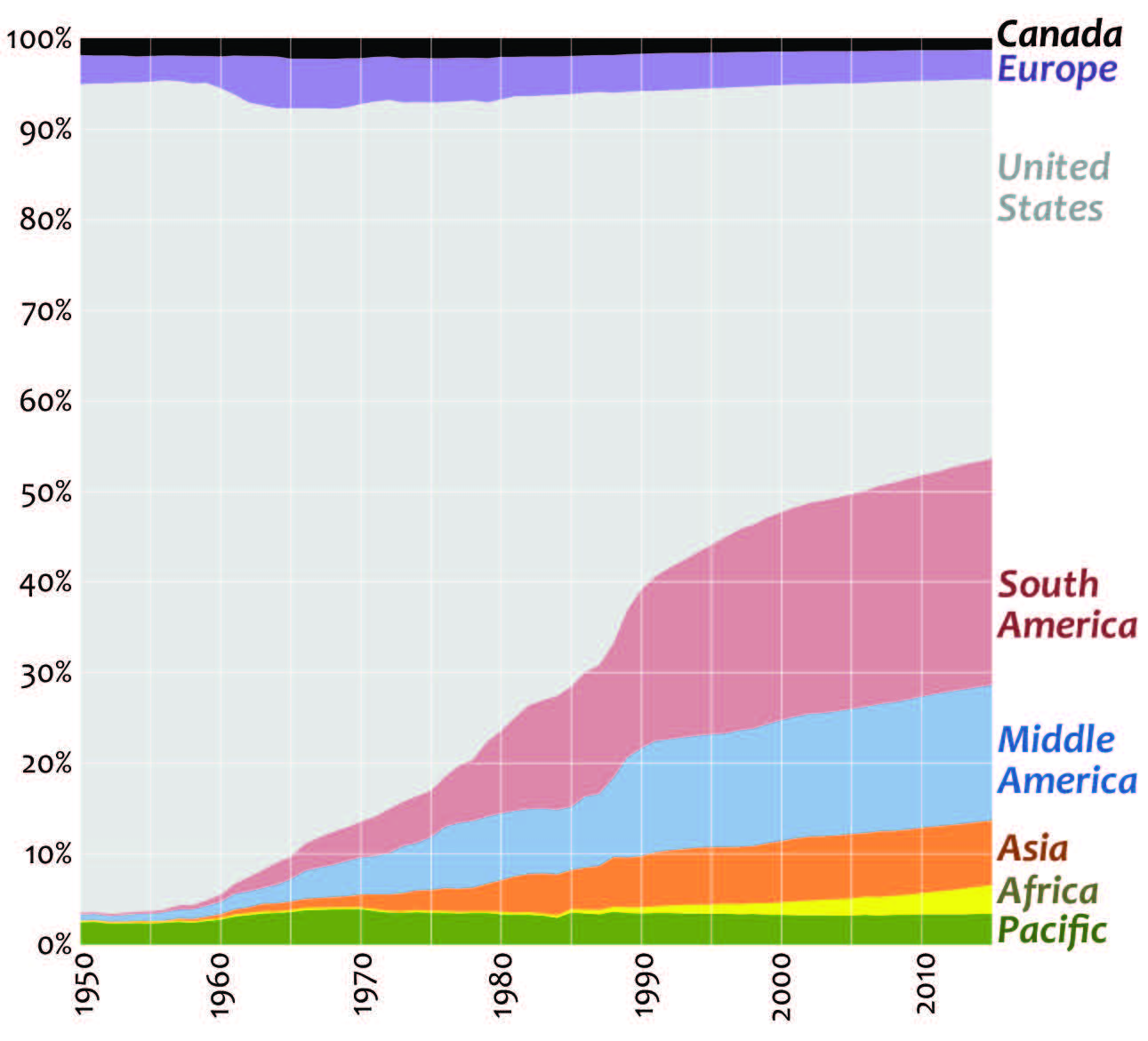
As the graph in figure 19.12 shows, the world growth pattern of the Church, propelled by a succession of regional growth engines, has typically been higher than that of either the United States or Canada over the past five decades. In Canada, the Church’s membership growth pattern over the long haul has been more like that in the United States, sharing, as the graph indicates, the same general trends and fairly consistent growth over a substantial period of time.
Religiosity in the United States and Canada
While Canada and the United States are both predominantly Christian nations, Canada has a higher percentage of Catholics to Protestants than the United States, accounted for in large part by the sizable French Catholic population in Quebec. As indicated earlier, Canada in 1951 had 46 percent Catholics (including Orthodox) and 50 percent Protestants. By 2011, these numbers had declined to 41 percent Catholics (including Orthodox) and 27 percent Protestants. In the United States during the 1960s, more than two-thirds of the population were Protestant, declining to about 50 percent in 2013. Catholics in the United States have been holding steady at about one-quarter of the population.[42] However, the composition of the Catholic population has been becoming more diverse, changing because of immigration from countries where Catholicism is a majority religion. The pattern of declining religiosity in the two countries has been similar over recent decades, except the trend seems to have manifested itself earlier in Canada than in the United States.
Sociologists and others who study religion often configure their analyses of religiosity in terms of three distinct aspects or dimensions: belonging, behaving, and believing. Though interrelated, taken together, these establish a framework for the measure of religiosity. Perhaps the most basic of these dimensions is belonging—identifying with or affiliating with a religion. The majorities of both Canadians and Americans identify or affiliate with a religion, and of those who do, the majorities identify with one of the various branches of Christianity.
Top: Religious Affiliation in Canada, 1941–2011 Bottom: Figure 19.13b Religious Affiliation in the United States, 1948–2015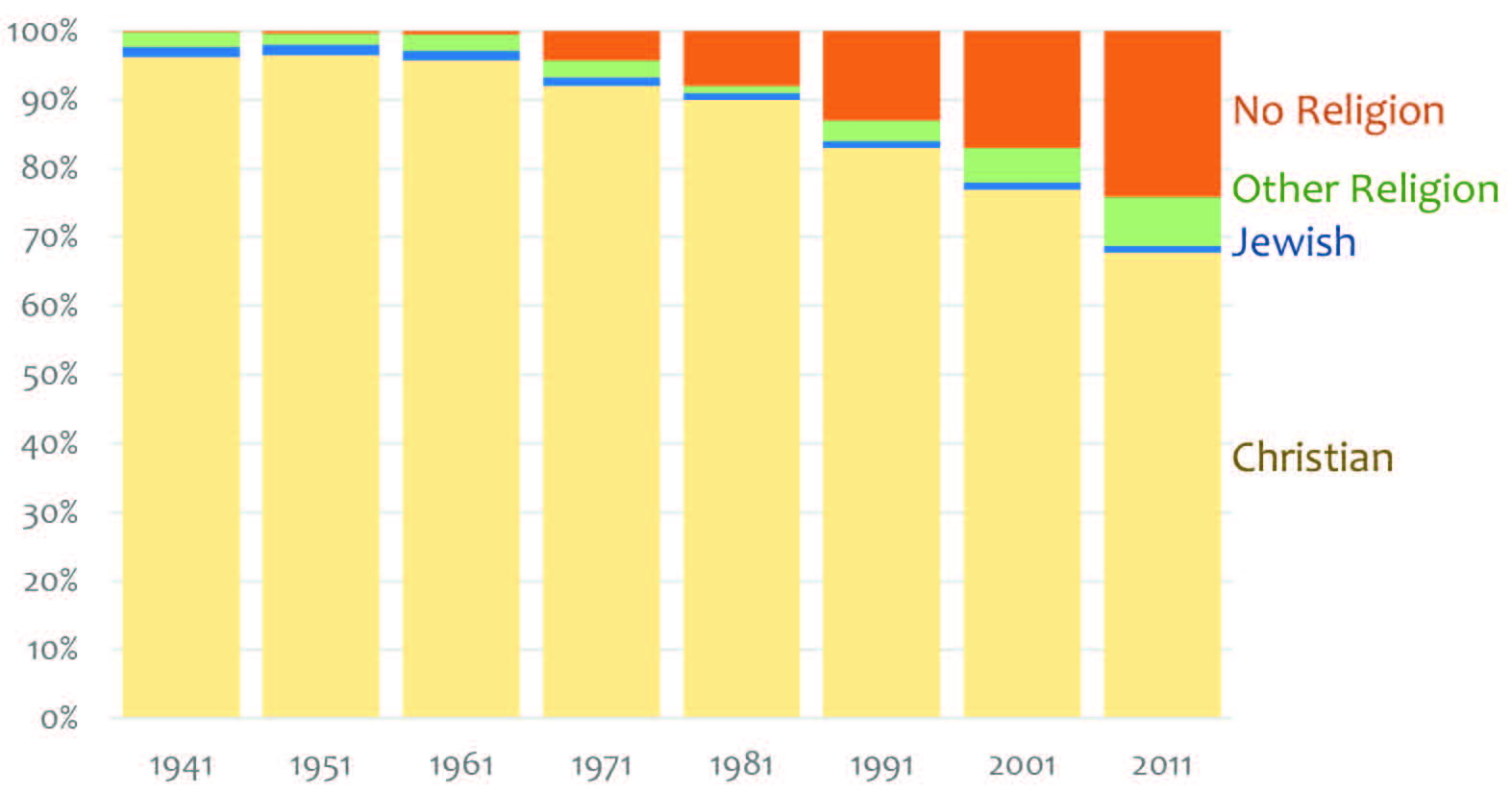
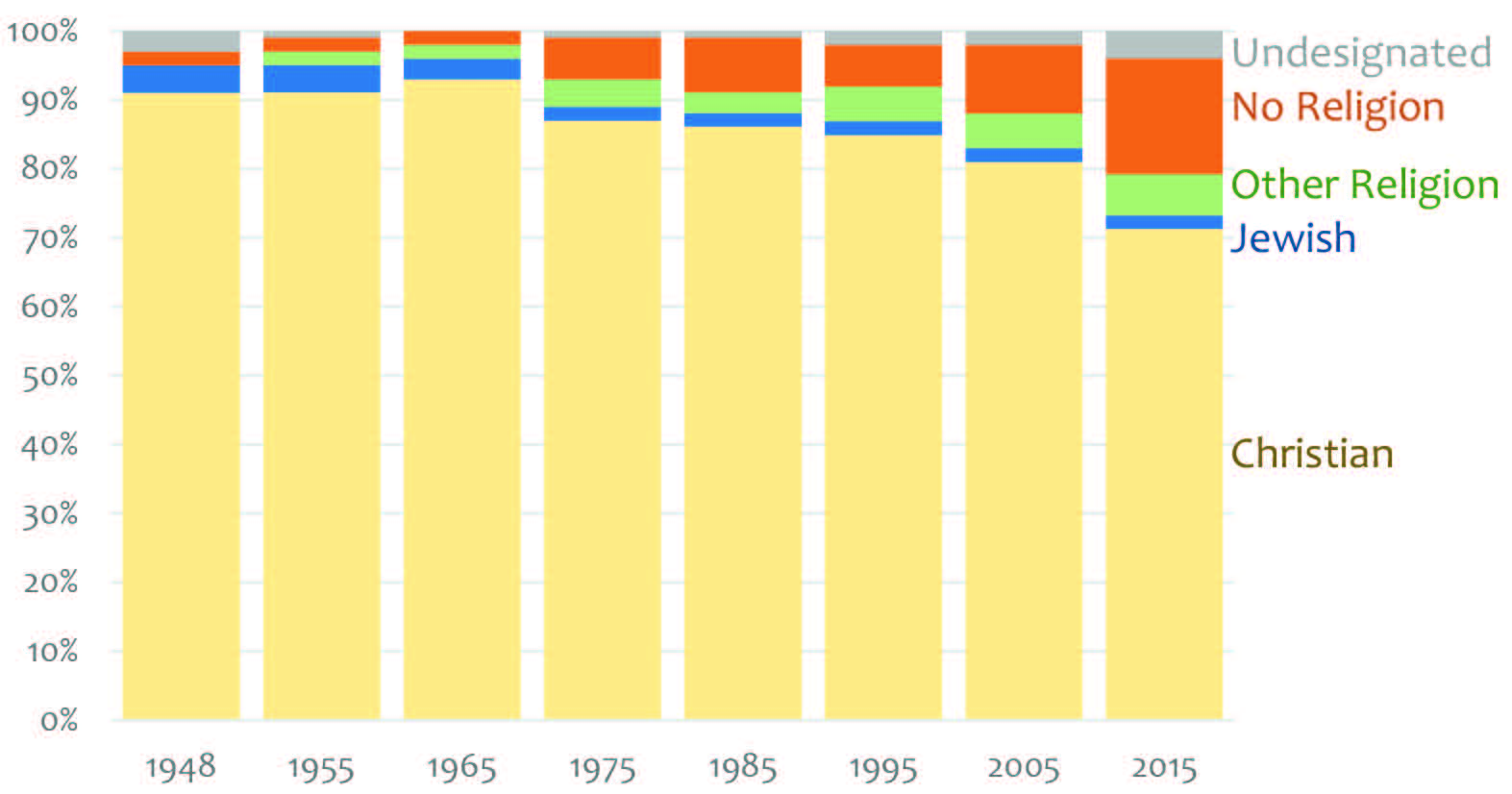
In recent decades, however, the percentages of both Canadians and Americans who identify with a religion have been trending downward. This downward trend is mainly the result of a decline in the proportions of Canadians and Americans who identify with Christianity. Meanwhile, the percentages of those who identify with non-Christian religions and those who report having no religious affiliation have been trending upward in both countries. These trends can be clearly seen in the data presented in figure 19.13a (Canadian affiliation trends) and figure 19.13b (American affiliation trends). These trends appear to be proceeding a little more apace in Canada than in the United States. It is important to note that there are clear generational differences in both Canada and the United States, as illustrated in figure 19.14. The younger the age group, the higher the rate of disaffiliation.

A second aspect or dimension of religiosity is behaving—acting in ways consistent with the expectations of a religion, whatever that religion may be. One specific behavior often used in surveys to measure this aspect of religiosity is attendance at religious services or public prayers. The bar is often set quite low, as in the example used here: attendance at religious services at least once a month.
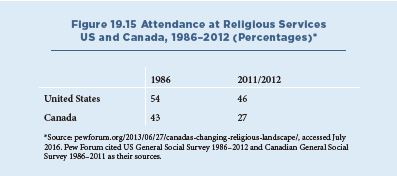
Figure 19.15 shows that percentages of respondents who answer yes to this question have declined in recent decades in both Canada and the United States. At least on this measure, Canadians as a group seem to exhibit less religious behavior than Americans. We see in both survey years, as the age groupings get progressively younger, the percent attending religious services at least once a month becomes lower. We also see that for each age grouping the percent attending at least once a month has lessened over a twenty-year period between 1988 and 2008.
A third aspect of religiosity, perhaps the most difficult to measure, is belief—the acceptance of religious teachings and doctrines as true. The archetypical question is often a simple variation of “Do you believe in God?” The Gallup organization began asking this question of Americans in 1944, when 96 percent of respondents answered yes. In 1976, it changed its question to “Do you believe in God or a universal spirit?” Then, in 2011, they asked both questions, presumably in different surveys.
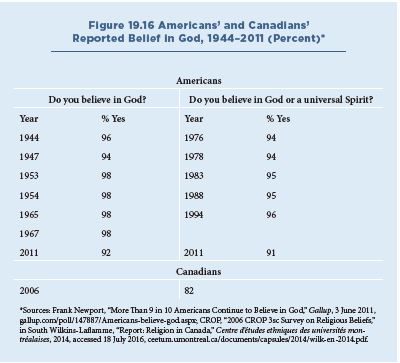
Figure 19.16 shows how many respondents answered yes to these questions over a span of sixty-seven years.[43] Americans’ belief in God appears to have been fairly stable over many years and appears to remain strong. Similar longitudinal data for Canada is difficult to find. However, a poll by a Canadian polling organization in 2006 found that 82.3 percent of respondents reported belief in God.[44]
The three aspects of religiosity do not always trend up or down in lockstep. Individuals may affiliate with a religion and attend religious services and other activities for a variety of nonreligious reasons while not believing in God or religious doctrines at all. Likewise, other individuals may believe but not affiliate or engage in recognizable religious behaviours for a variety of reasons. Nonetheless, there appears to be reasonable evidence that in both the United States and Canada there has been a lessening of both religious affiliation and religious behavior in recent decades in the two countries’ populations generally, but more noticeably among younger people.
Religious and Political Polarization: United States
A recent study by two political science professors, Robert D. Putnam from Harvard University and David E. Campbell from Notre Dame, of the “religious landscape” in the United States concluded, among other things, that the nature of religious tension in that country has undergone a significant shift.[45] The study covered a period of more than half a century from the 1950s to the early 2000s. In the 1960s, the tension was essentially a rivalry among Christian denominations (Catholic versus Protestant). In 2010, when the study concluded, it was essentially a polarized standoff between the “highly religious” at one pole and the “avowedly secular” at the other pole. The middle ground, occupied by moderates, appears to be shrinking.[46] A main theme of this polarization is identified as the “significance of personal and sexual morality.”[47]
Putnam and Campbell have attributed this shift to what they describe as “three seismic social shocks.”[48] The first of these occurred during what sociologists refer to as “the long sixties” (that is, the 1960s and the first few years of the 1970s), in which there was a broad social movement toward increased sexual freedom and license, among other espoused causes. The second shock was a strong conservative backlash to this movement during the 1970s and 1980s, resulting in the movement of many conservative Christians away from mainline churches to more conservative denominations, especially evangelical denominations. This led to growth in numbers and influence for conservative evangelical churches and a decline in some of the mainstream Christian denominations that had begun to adapt their teachings and practices to be more resonant with some of the changing social mores. This growth of conservative religious fervour began to merge with political conservatism and eventually resulted in political and religious movements such as the Moral Majority and more recently the Tea Party. Religion thus came to be associated in the public mind, especially among younger people, with conservative politics in general and the Republican Party especially. Similarly, left-leaning politics, and the Democratic Party in particular, came to be associated with secularism. Hence, the third shock began in the 1990s and 2000s and is ongoing as large numbers of young people, in reaction to the conservative backlash and its intermingling of religion and politics, are disavowing both religion and conservative politics altogether.
In an earlier study of social capital and civic engagement in the United States, Robert D. Putnam found that key indicators of religiosity were not alone in their decline during the last half of the twentieth century. Several other indicators showed remarkably similar patterns of decline as well, including such things as voter turnout, participation in partisan and political campaign activities, and attendance at public town or school board meetings. There was also a decline in membership in clubs or other community organizations, membership in unions and voluntary professional organizations, and membership in bowling leagues and other amateur team sports, as well as a decline in volunteerism, charitable donations, entertaining friends at home, family dinners, and even observance of stop signs. Putnam attributes these shifts in behavior to several factors, including generational change, the long-term effects of television and other forms of electronic entertainment, pressures of time and money in two-career families, and suburbanization and commuting. The decline of religiosity, then, appears to be one part of a larger pattern of social and community disengagement, especially among the younger generations.[49]
 Latter-day Saints place a high value on community service. Members of the Magrath Fifth Ward of the Magrath Alberta Stake are shown here preparing Thanksgiving dinner at the Lethbridge Soup Kitchen in 2016. (Patricia Whitehead)
Latter-day Saints place a high value on community service. Members of the Magrath Fifth Ward of the Magrath Alberta Stake are shown here preparing Thanksgiving dinner at the Lethbridge Soup Kitchen in 2016. (Patricia Whitehead)
We can see echoes of Putnam and Campbell’s analysis in both the Canadian and American religiosity data presented previously in terms of the beginning of gradual decline in religious affiliation in the 1960s and 1970s and more steep declines, especially among young people beginning in the 1980s and continuing into the 1990s and 2000s.
Looking at the LDS Church growth rate for the United States in figure 19.4, we can also see what may well be an echo of Putnam and Campbell’s analysis. The graph shows an increase in the annual percentage growth rate beginning in 1973. The rate continues to be high until about 1987, when the growth rate begins to trend gently downward. This bump up in the percentage growth rate occurred during the two decades (1971 to 1990) of the strong conservative backlash against the liberalizing social movement begun in the 1960s. It was during these two decades that large numbers of people were moving to churches with more conservative approaches to morality. The Church of Jesus Christ of Latter-day Saints is known as being conservative in its views relating to sexual and personal morality, and this may have been one factor in the rise in the member growth rate in the United States during the 1973 to 1987 period. Putnam and Campbell concluded that the three most religiously observant groups in America, in descending order, are Mormons, Black Protestants, and Evangelical Protestants. This clearly puts the LDS Church into the category of conservative religious groups.[50] This same reputation may also have been one factor in the subsequent decline of the member growth rate in the United States, as many young people turned away from religion during the 1990s and 2000s. The member growth rate line for Canada in figure 19.4 is similar to the American growth rate line over the same period.
The trend appears to be one common to Western societies. In her study of Western secularization (read de-Christianization), Mary Eberstadt has argued for elaborating existing theories of secularization. Existing theories, she writes, are grounded in socioeconomic factors and have much to offer, but they overlook an important factor that she labels the “family factor.” She uses the metaphor of the intertwined strands of DNA molecules to argue that the decline of Christianity and family in the West are intimately intertwined, a case of mutual causality. Among other lines of argument, she connects the Lambeth Conference of 1930—during which the Anglican Church approved a resolution allowing for a limited number of carefully delineated exceptions to the policy against contraception through the relaxation of some other policies, all of which are related to the concept of the family in some way—to the church’s approval of same-sex marriage in the early twenty-first century.[51]
Religious Polarization: Canada
Reginald W. Bibby has argued that the current religious situation in Canada is best understood in terms of polarization.[52] The Angus Reid Institute (ARI) appears to have used Bibby’s conceptual framework in a 2015 national study of Canadians’ attitudes toward religion.[53] Respondents were asked to place themselves into one of three categories: (1) inclined to embrace religion, (2) inclined to reject religion, or (3) somewhere in between. The results of the study are very detailed and cannot all be summarized here, but they tend to support the polarization hypothesis. At one pole position are the 30 percent of all respondents who chose inclined to embrace religion. As might be expected, this group ranks very high on the religiosity indicators used in the study. At the opposite pole are the 26 percent who chose inclined to reject religion. This group ranks very low on the religiosity indicators. In between these two polar groups are the 40 percent of all respondents who chose somewhere in between. This was the largest group, described both as ambivalent and as the “mushy middle.” As a group, they are middle-of-the-road on most of the religiosity indicators used in the study.
The Angus Reid study, though very valuable, did not provide the kind of rich sociopolitical analysis as found in the American studies cited previously. Nonetheless, it provides evidence that the religious landscapes of both the United States and Canada are polarizing.
The Global Religious Landscape
Figure 19.17 Religions by Percent of World Population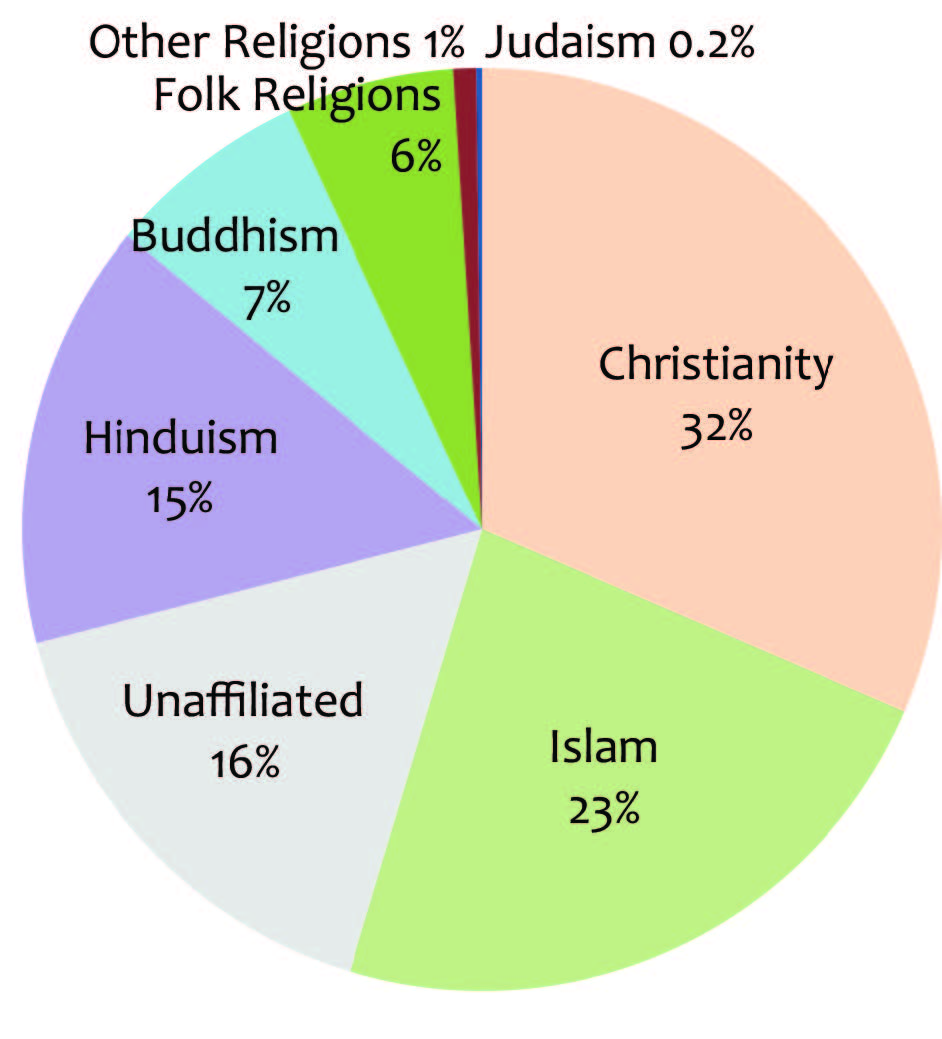
The pie chart in figure 19.17 shows the estimated percentages of the world’s total population who are identified with the world’s largest religious groups (as of 2010). Christianity is the world religion with the largest percentage of adherents, though it accounts for slightly less than one-third of the world’s population. It is followed by Islam, which accounts for just less than one-quarter of the world’s population. Those who are unaffiliated with any religion are next, at about one-sixth of the population, followed in turn by Hinduism, Buddhism, folk religions, other religions, and Judaism.[54] In this data set, The Church of Jesus Christ of Latter-day Saints is included as a subset of Christianity and is not shown separately. However, at the end of 2010, the Church had 14,131,467 members,[55] or about 0.2 percent of the world population, virtually identical to the world’s Jewish population, and up from about 0.04 percent of the world population in 1950.[56] Perhaps Mormons, like Jews, are beginning to have an influence worldwide in excess of that which their numbers would suggest.[57] As indicated in other chapters, Canadian Saints have played a significant role in a variety of fields, particularly in general Church leadership. As Elder M. Russell Ballard has affirmed, “The testimony of the Canadian Saints is felt all over the world.”[58]
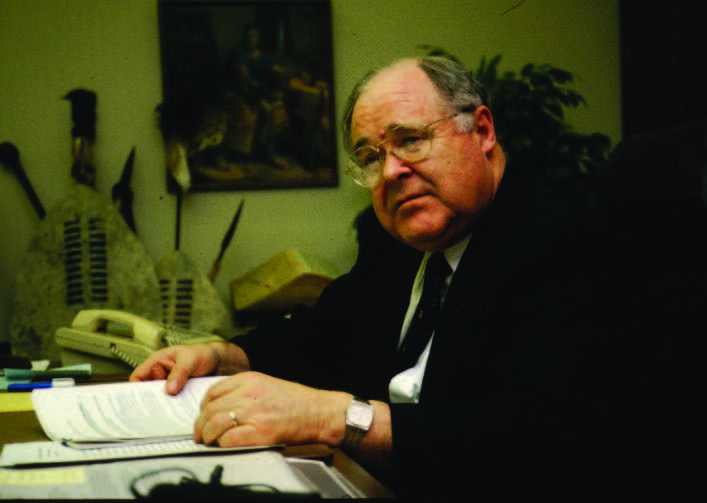 Alexander B. Morrison, born in Edmonton, Alberta, had a distinguished career, including being Deputy Minister of the Canadian Department of Health and Welfare and chairman of several committees of the World Health Organization dealing with tropical diseases and public health in developing areas of the world. Called as a General Authority in 1987, he supervised the Church in England and Africa. (IRI)
Alexander B. Morrison, born in Edmonton, Alberta, had a distinguished career, including being Deputy Minister of the Canadian Department of Health and Welfare and chairman of several committees of the World Health Organization dealing with tropical diseases and public health in developing areas of the world. Called as a General Authority in 1987, he supervised the Church in England and Africa. (IRI)
A New World Religion?
In the years following World War II, some historians and sociologists of religion have begun to watch The Church of Jesus Christ of Latter-day Saints more seriously and more dispassionately than was previously the case. Some have even suggested that Mormonism could become the next great world religion.
In 1957, ten years after the Church’s membership reached the one-million mark, Thomas F. O’Dea published his sociological study, The Mormons.[59] Drawing on his field research done in Mormon communities in the western United States, O’Dea reviewed the history of the Church to that time and examined its values, its social institutions, and its sources of strain and conflict. In his conclusions, O’Dea wrote that “Mormonism” had developed “a peculiarly American religion” and “a peculiarly American subculture that has survived fierce opposition and surmounted tremendous obstacles.” He defended the Church against critics who thought that it was merely a product of frontier America; that its organization, practices, and mindset had allowed it to do well during the frontier period but that such characteristics were no longer useful or viable in the postfrontier era; and that because of this the Church would surely fade into oblivion in the modern world. He acknowledged that the Church was then in a difficult period of transition, but he saw signs that it could successfully spread out from its mountain retreats into mainstream America. “The Mormon movement,” he wrote, “may be on the eve of its Diaspora.”[60] O’Dea’s conclusions have proven prescient. Since his study was published six decades ago, the Church has grown dramatically in number of members and has spread from its mountain retreats in the western United States not only into mainstream America but into all of North, Central, and South America and increasingly into other areas of the world as well.
In 1984, the year LDS Church membership reached 5.65 million, sociologist Rodney Stark published what he thought would be a minor article titled “The Rise of a New World Religion.”[61] In the article, he made some bold projections regarding the possible growth of the Church, based on his stated assumption that the Church would continue to grow at a rate similar to its historic growth rates. If Church membership grew at a rate of 30 percent per decade going forward, it would surpass 60 million members by 2080, about a century later. Or, if membership grew at a rate of 50 percent per decade, it would surpass 265 million members by 2080. The article produced a storm of controversy among scholars of religion—controversy that focused mainly on his method of producing the projections.[62] Nonetheless, Stark stuck to his forecasts and defended them in a 1996 follow-up article[63] and later in a chapter of his 2005 book, The Rise of Mormonism.[64] The LDS Church, he said, “stands on the threshold of becoming the first major faith to appear on earth since Muhammad rode out of the desert.”[65] Unfortunately, as shown in figure 19.1 above, in the decade following 2000 (2001–10), the growth rate fell to about 28 percent and appears likely to be in the range of about 21 percent when the current decade (2011–20) ends.
In 1985, historian of religion and religious studies scholar Jan Shipps published Mormonism: The Story of a New Religious Tradition, in which she argued that just as primitive Christianity grew out of, but became distinctly different from, ancient Judaism, Mormonism likewise grew out of, but became distinctly different from, what she calls traditional Christianity. The upshot of her analysis is the conclusion that “Mormonism is a new religious tradition.”[66] Fifteen years later, in 2000, Shipps wrote that the last quarter of the twentieth century had been just as difficult in terms of dramatic change and adjustment for the Latter-day Saints as was the last quarter of the nineteenth century. “It is no longer a regional faith,” she wrote, “much less an American Faith.”[67]
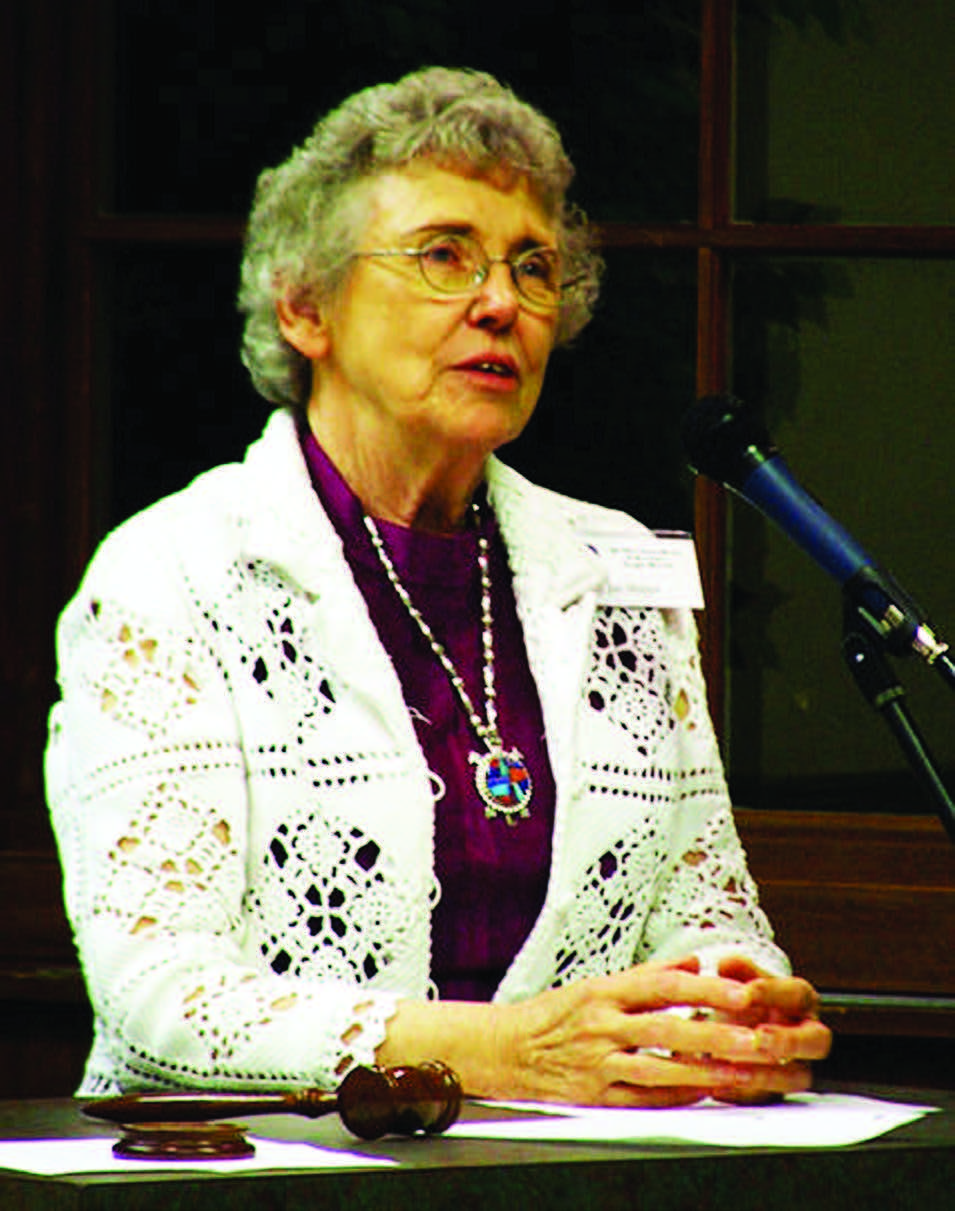 Jan Shipps, a noted scholar of Mormonism, has postulated that Mormonism is a new religious tradition arising from traditional Christianity, much as Christianity derived from Judaism. She sees a bright future for Mormonism as it expands across the world. (Jan Shipps)
Jan Shipps, a noted scholar of Mormonism, has postulated that Mormonism is a new religious tradition arising from traditional Christianity, much as Christianity derived from Judaism. She sees a bright future for Mormonism as it expands across the world. (Jan Shipps)
Five years later, in 2005, speaking at a two-day international conference cosponsored by the United States Library of Congress and Brigham Young University, Shipps acknowledged Joseph Smith’s prophetic vision of a worldwide church as well as Brigham Young’s leadership in colonizing and building the Mormon communities in the Intermountain West, but went on to identify the post–World War II presidency of David O. McKay (1951–70) as the period in which “the transformation of Mormonism from provincial tradition to global religious force” really began to take place.[68] She pointed to the restructured missionary program, the increase in the number of meetinghouses and temples built, and the beginnings of the correlation program as significant developments during the McKay presidency. She also noted the presidency of Spencer W. Kimball (1973–85) for the 1978 revelation that made the priesthood available to all worthy males, which, she said, made the Church’s message more universal.[69] Gordon B. Hinckley’s tenure as Church President (1995–2008), she said, “has been devoted to completing the ‘conversion’ that would make the church and its gospel message universal enough to make itself at home in myriad places and many different cultures.”[70]
In addition to the historians and sociologists, several theologians and other scholars of religion have begun to examine the Church more closely, especially in relation to the doctrinal appeal of Mormonism: the nature of God, the plan of salvation, the Book of Mormon as additional scripture, and the centrality of Jesus. Stephen H. Webb, a prominent Catholic theologian, has looked at Mormon theology with a view to identifying what other Christians can learn from Mormons and vice-versa.[71] Terryl L. Givens, a prominent Latter-day Saint scholar, has written about the foundations of Mormon thought and the Book of Mormon and has brought widespread attention to the notion of a personal God who shares and understands human emotions.[72] In that same conference cosponsored by the United States Library of Congress and Brigham Young University in 2005, noted scholars from many disciplines discussed the virtues of Mormonism, appraised the merits of its theology, and lauded the accomplishments of its founder, Joseph Smith.[73] In a world of shifting values and widespread confusion, the theological stability of Mormonism focusing on Jesus Christ and the plan of salvation has a wide appeal, while many are attracted to the concept of modern-day prophets and additional scriptures.
Conclusions
The decades following World War II have been a time of intense growth and internationalization for The Church of Jesus Christ of Latter-day Saints. The Church expanded its membership from 1 million in 1947 to more than 15.6 million in 2015. Its global presence grew from less than 50 countries in 1950 to 158 countries in 2015, with members, congregations, and temples now on every continent and on many isles of the sea. This growth of membership and increased global reach has resulted in a dramatic shift in the balance of membership away from the United States of America. In 1950, 98 percent of members lived within the United States. By 2015, 58 percent of members lived outside the United States. Though the bulk of the membership is still located in North, Central, and South America and the Caribbean, there has been significant membership growth in sub-Saharan Africa and some parts of Asia in recent decades. The cadre of full-time missionaries expanded exponentially in the postwar period, with more than half a million missionaries called between 1990 and 2007 alone, and an additional three hundred thousand, approximately, by 2013.
During the postwar period, the religious landscape in both Canada and the United States has been polarizing, and some measures of religiosity have been gradually declining. Though affiliation with a religion and belief in God remain the norm, both non-Christian religions and religious disaffiliation have been gaining ground. Younger generations especially, in both Canada and the United States, have been moving away from organized religion. At the same time, historians, sociologists, and scholars of religion generally have been giving more dispassionate attention to the Church, many considering Mormonism to be a new religious tradition that has the possibility of becoming a great world religion. Decline in LDS growth rates in both Canada and the United States correlate reasonably well with this general decline of religiosity in these two countries.
The Church in Canada has nevertheless been part of this robust worldwide growth and globalization of the Church and of the dynamic shifts in the North American religious landscape since the Second World War. As other chapters in this book have indicated, apart from the Mormon settlement area of southern Alberta, which has maintained close Utah ties, Latter-day Saint culture in Canada has evolved and blended in to some degree with a universal Church culture with some distinctively Canadian trappings. Nonetheless, in terms of growth, the Canadian pattern has been more like that of the United States than that of Church growth worldwide. This is explained by somewhat similar cultures, with a stronger religiosity generally in the United States than in Canada. The Church in Canada, though a small percentage of the global Church membership, has nonetheless made a significant contribution both to the Church and to Canada.
The answer to the question which has so tantalized scholars of whether The Church of Jesus Christ of Latter-day Saints is an emergent “world religion” is clearer to Latter-day Saints. Based on their faith in modern prophetic utterances, in which the little stone cut out of the mountain will fill the earth, the Church has just begun in its mission to eventually spread worldwide and to “fill the whole earth” in preparation for the Second Coming of Jesus Christ (D&C 42:28–30, 65; Moses 7:59–67, especially 62).
Notes
[1] Brook P. Hales, “Statistical Report, 2015,” Ensign, May 2016, 45. All membership and population numbers cited in this chapter should be regarded as estimates only. When such numbers are in the hundreds of thousands, millions, and even billions, it is virtually impossible to achieve 100 percent accuracy.
[2] Richard Lyman Bushman, Joseph Smith: Rough Stone Rolling (New York: Alfred A. Knopf, 2005), 109.
[3] History, 1838–1856, volume C-1 [2 November 1838–31 July 1842], The Joseph Smith Papers, josephsmithpapers.org/
[4] The Church of Jesus Christ of Latter-day Saints, “History of Missionary Work in the Church,” News Release, 25 June 2007, mormonnewsroom.org/
[5] Hales, “Statistical Report, 2015,” 45.
[6] Dean Perkins, Membership and Statistical and Records Division, The Church of Jesus Christ of Latter-day Saints, email to Stephen V. Beck, Country Profile Manager, Church History Library, 28 March 2016.
[7] “Facts and Statistics,” mormonnewsroom.org/
[8] The LDS Church has formal procedures for both voluntary and non-voluntary cessation of membership. Members who voluntarily leave the Church, but who do not follow the formal procedure, may continue to be counted as members, even though they do not consider themselves as such.
[9] When children of record are not baptized and confirmed at age eight, their membership, in effect, lapses. Hence, when they are baptized at the age of nine or older, they are counted as converts. Adult converts who have children younger than eight years old may opt to have those children listed as children of record.
[10] During the forty-four-year period, there were 3,522,882 children of record in total, an average of about 80,066 per year; and 10,455,116 converts in total, an average of about 237,616.3 per year.
[11] The estimates in this paragraph were derived from analyzing yearly statistical reports presented in the annual general conferences of the Church. Note that from 1977 through 1991, numbers for children of record confirmations were rounded to (presumably) the nearest thousand. From 1978 through 1982, numbers for convert confirmations were also rounded to (presumably) the nearest thousand. Membership losses were estimated by taking the total membership figure for the end of 1970, adding new children of record and converts reported for years 1971 through 2014, and subtracting that sum from the total membership figure reported for the end of 2014.
[12] James B. Allen and Richard O. Cowan, “History of the Church: c. 1945–1990, Post–World War II International Era Period,” in Daniel H. Ludlow, ed., Encyclopedia of Mormonism (New York: Macmillan, 1992), 2:638–47.
[13] Richard O. Cowan, interview by Carole Mikita, People of Faith, KSL Radio, 26 January 2014.
[14] Deseret News, 2004 Church Almanac, Salt Lake City.
[15] Brandon S. Plewe et al., eds., Mapping Mormonism: An Atlas of Latter-day Saint History (Provo, UT: Brigham Young University Press, 2012), 156–57.
[16] “Facts and Statistics,” mormonnewsroom.org/
[17] Plewe et al., Mapping Mormonism, 174.
[18] Church membership estimates and the assignment of countries into regions are those used by “Facts and Statistics,” mormonnewsroom.org/
[19] World population estimates used here are from Wikipedia. This source was chosen because the grouping of countries into regions for the population estimates varies only slightly from the Church’s grouping of countries for its membership numbers. The differences are minor and mostly relate to countries which straddle the divide between Europe and Asia.
[20] “Canada’s Population Estimates: Age and Sex, July 1, 2015,” Statistics Canada, statcan.gc.ca/
[21] Decades later, the property was reacquired and the Nauvoo Temple was rebuilt. Dedicated in 2002, it became the Church’s 113th operating temple.
[22] A small, temporary temple called the Endowment House was built on Temple Square in Salt Lake City, Utah, and dedicated on 5 May 1855. The building was in service for thirty-four years while the iconic Salt Lake Temple was under construction. See Lamar C. Barrett, “Endowment Houses,” in Encyclopedia of Mormonism, vol. 2, 456. See also Doctrine and Covenants, Official Declaration 1.
[23] The Provo City Center Temple, created from the burned-out shell of the old Provo Tabernacle, became the 150th operating temple, dedicated on 20 March 2016.
[24] “One Million Missionaries, Thirteen Million Members,” 25 June 2007, mormonnewsroom.org/
[25] “One Million Missionaries, Thirteen Million Members.”
[26] “One Million Missionaries, Thirteen Million Members.”
[27] “A Global Christ-Centered Faith,” mormonnewsroom.org/
[28] “LDS Missionary Numbers to Peak at 88,000,” interview with Elder David F. Evans, Deseret News, 3 July 2014.
[29] Hales, “Statistical Report, 2015,” 45.
[30] “How and When Were the First Mormon Sister Missionaries Called?” mormonnewsroom.org/
[31] “LDS Missionary Numbers to Peak at 88,000.”
[32] “Principal Religious Denominations of the Population, Census Dates 1871 to 1971,” Statistics Canada.
[33] “1981 Canada Census,” Statistics Canada.
[34] Data from the 2011 National Household Survey (NHS) may not be as reliable as data collected in previous “long form” census questionnaires because participation was voluntary rather than mandatory.
[35] “Canada’s Changing Religious Landscape,” Pew Research Center, 27 June 2013, based on data from Statistics Canada’s National Household Survey 2011.
[36] Reginald Bibby “Religion in Canada is Changing, But It’s not Being Abandoned,” The Globe and Mail, 8 May 2013.
[37] “Canada’s Changing Religious Landscape.”
[38] See Stewart C. Reid, “Why Religious Denominations Decline and How to Fix It,” Deseret News, 23 March 2017; D. M. Haskell, K. N. Flatt, and S. Burgoyne, “Theology Matters: Comparing the Traits of Growing and Declining Mainline Protestant Church Attendees and Clergy,” in Review of Religious Research 58, no. 4 (December 2016): 515–41.
[39] “Canada’s Changing Religious Landscape.” See also Daniel H. Olsen, Brandon S. Plewe, and Jonathan A. Jarvis, “Historical Geography: Growth, Distribution, and Ethnicity,” herein.
[40] “Canada’s Changing Religious Landscape.”
[41] Michael A. Goodman “The Worldwide Reach of Mormonism,” BYU Religious Education Review, Winter 2015, 22–25
[42] “Canada’s Changing Religious Landscape.”
[43] When Gallup asked about belief in God and presented respondents with answer options other than yes or no, the percentages changed. In 2006, respondents could choose from a five-point scale: 73 percent chose “convinced God exists,” 14 percent chose “probably exists, have a little doubt,” 5 percent chose “probably exists, have a lot of doubt,” 4 percent chose “probably does not exist but not sure,” 3 percent chose “convinced God does not exist,” and 2 percent “no opinion.” In 2007 a three-point scale was offered: 86 percent chose “believe in God,” 8 percent chose “not sure,” and 6 percent chose “don’t believe in God.” Frank Newport, “More than 9 in 10 Americans Continue to Believe in God,” gallup.com/
[44] CROP Inc. 2006 poll, reported in Sarah Wilkins-Laflamme, “Report: Religion in Canada,” Centre d’études ethniques des universités montréalaises, ceetum.umontreal.ca/
[45] Robert D. Putnam and David E. Campbell, American Grace: How Religion Divides and Unites Us (New York: Simon and Schuster, 2012). The original hardcover edition was published in 2010. The Paperback edition includes additional updates to 2011.
[46] Putnam and Campbell, American Grace, 3.
[47] Putnam and Campbell, American Grace, 82.
[48] Putnam and Campbell, American Grace, 3.
[49] Robert D. Putnam, Bowling Alone: The Collapse and Revival of American Community (New York: Simon and Schuster, 2000).
[50] Putnam and Campbell, American Grace, 23–24.
[51] Mary Eberstadt, How the West Really Lost God: A New Theory of Secularization (West Conshohocken, PA: Templeton Press, 2013).
[52] Reginald W. Bibby, “Why Bother with Organized Religion? A Response to Joel Thiessen,” The Canadian Review of Sociology 49, no. 1 (February 2012): 91–101. See also Bibby’s opinion piece, “Religion in Canada is Changing, but It’s Not Being Abandoned,” in The Globe and Mail, Toronto, Wednesday, 8 May 2013.
[53] Angus Reid Institute, “Religion and Faith in Canada Today: Strong Belief, Ambivalence, and Rejection Define Our Views,” posted 26 March 2015.
[54] Pew Research Center, The Global Religious Landscape: A Report on the Size and Distribution of the World’s Major Religious Groups as of 2010, 2012,
pewforum.org/
[55] Brook P. Hales, “Statistical Report, 2010,” Ensign, May 2011, 29.
[56] World population in 1950: 2,557,628,654 (US Census Bureau estimate); LDS Church Membership in 1950: 1,111,314. Deseret News 2012 Church Almanac (Salt Lake City: Deseret News, 2012).
[57] Victor L. Ludlow, “The Scattering and Gathering of Israel: God’s Covenant with Abraham Remembered through the Ages,” in Window of Faith: Latter-day Saint Perspectives on World History, ed. Roy A. Prete (Provo, UT: Religious Studies Center, 2005), 97–120.
[58] Elder M. Russell Ballard, Pan-Ontario stake conference broadcast, 21 August 2016. See also Helen K. Warner et al., “Mormons Who Made a Difference,” in The Mormons: An Illustrated History of The Church of Jesus Christ of Latter-day Saints, ed. Roy A. Prete (London and New York: Merrell, 2013), 136–49.
[59] Thomas F. O’Dea, The Mormons (Chicago: University of Chicago Press, 1957). In 2008, a collection of papers was published to mark the fiftieth anniversary of The Mormons. See Revisiting Thomas F. O’Dea’s The Mormons: Contemporary Perspectives, ed. Cardell K. Jacobson, John P. Hoffman, and Tim B. Heaton (Salt Lake City: University of Utah Press, 2008).
[60] O’Dea, Mormons, 258–63. O’Dea explained that in using the word “diaspora,” he did not intend to imply that the central city would cease to be central, but that belongingness would no longer be identified with a specific place.
[61] Rodney Stark, “The Rise of a New World Faith,” Review of Religious Research 26, no. 1 (September 1984).
[62] For a recent brief discussion of the complexities and methods of producing growth projections for the LDS Church, see “The Future of the Church: 2010–2040,” in Plewe et al., Mapping Mormonism, 202–3.
[63] Rodney Stark, “So Far, So Good: A Brief Assessment of Mormon Membership Projections,” Review of Religious Research 38 (December 1996): 175–78.
[64] Rodney Stark, The Rise of Mormonism, ed. Reid L. Neilson (New York: Columbia University Press, 2005).
[65] The Rise of Mormonism, Chapter 7. See also Gerald R. McDermott “Testing Stark’s Thesis: Is Mormonism the First New Religion Since Islam?” in Richard L. Bushman et al., eds., The Worlds of Joseph Smith: A Bicentennial Conference at the Library of Congress, special issue of BYU Studies 44, no. 4 (2005): 271–92.
[66] Jan Shipps, Mormonism: The Story of a New Religious Tradition (Urbana and Chicago: University of Illinois Press, 1985), 149.
[67] Jan Shipps, “The Scattering of the Gathering and the Gathering of the Scattered: The Mid-Twentieth-Century Mormon Diaspora” in Sojourner in the Promised Land: Forty Years among the Mormons (Urbana and Chicago: University of Illinois Press, 2000).
[68] The conference was held to mark the bicentennial of Joseph Smith’s birth. The proceedings were published in ed. Bushman et al., Worlds of Joseph Smith.
[69] See Doctrine and Covenants, Official Declaration 2. Spencer W. Kimball was also instrumental in revisioning the volunteer, full-time missionary cadre to include more young people from second- and third-world countries.
[70] Jan Shipps, “Joseph Smith and the Making of a Global Religion,” in Bushman et al., Worlds of Joseph Smith, 293–305. Gordon B. Hinckley will also be remembered for both his aggressive approach to building temples throughout the world, and for inaugurating the Perpetual Education Fund, which provides loans to qualifying young members of the Church in second- and third-world countries to enable them to obtain training that will increase their employability.
[71] Stephen H. Webb, Mormon Christianity: What Other Christians Can Learn from the Latter-day Saints (New York: Oxford University Press, 2013)
[72] Terryl L. Givens, By the Hand of Mormon: The American Scripture That Launched a New World Religion (New York: Oxford University Press, 2002); Terryl L. Givens, Wrestling the Angel: The Foundations of Mormon Thought: Cosmos, God, Humanity (New York: Oxford University Press, 2015); Terry and Fiona Givens, The God Who Weeps: How Mormonism Makes Sense of Life (Salt Lake City: Ensign Peak, 2012).
[73] Bushman et al., Worlds of Joseph Smith.
